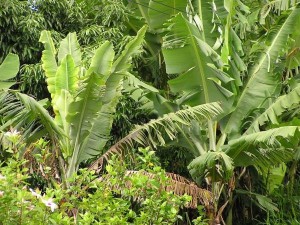
The plant on the left is infested with BBTV. Note how the new growth is bunched together, a symptom that gives the disease its name. Photo courtesy of Scott Nelson, UH-College of Tropical Agriculture and Human Resources
(BBTV)
Banana bunchy top virus is a devastating pathogen that affects banana plants. BBTV stunts the growth of banana plants and fruit. There is no cure for this virus and banana plants will stop producing fruit and die. BBTV is spread between plants by the banana aphid (Pentalonia nigronervosa), and people introduce the disease by moving infected plant material into the area.
Watch a video:
Description:
- shrunken malformed leaves “bunching” at the top
- “Morse code” dark green streaking on the leaf stem
- mottled and streaked flowers
- dark green streaks with “J” shape on midrib
- presence of the banana aphid (Pentalonia nigronervosa)
Harm:
- BBTV stunts the growth of banana plants and fruit.
- There is no cure for this virus and banana plants will stop producing fruit and die.
- BBTV is spread between plants by the banana aphid (Pentalonia nigronervosa).
- People introduce the disease by moving infected plant material into the area.
- All plants with BBTV should be quarantined and destroyed.
In Hawaii:
- Statewide – Banana bunchy top virus was first introduced to Hawai‘i in 1989. It was first seen on O‘ahu, then the disease made its way to the Big Island followed by Kauai.
- Maui – first detected in Pukalani in 2002. Since then, it has been found in Pukalani, Makawao, Kula, Kahului, Lahaina and Kīhei. As of 2014, BBTV is limited in West Maui, scattered in Haiku, and not known from the Keanae/Hana/Kipahulu area.
Don’t confuse with:
- Cucumber Mosaic Virus (CMV) is also spread by the banana aphid, but does not cause significant damage to banana fruit. Symptoms are mottling and streaking flowers. CMV does not cause the “Morse code” leaf streaking pattern of BBTV infected plants.
- Severe deficiencies of nutrients like calcium and boron cause yellowing and deformed growth of leaves.
